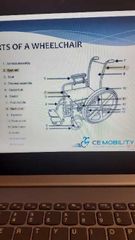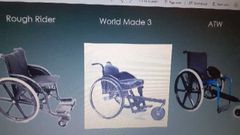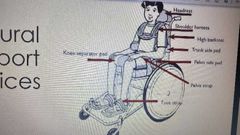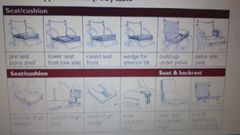![]()
![]()
![]()
Use LEFT and RIGHT arrow keys to navigate between flashcards;
Use UP and DOWN arrow keys to flip the card;
H to show hint;
A reads text to speech;
21 Cards in this Set
- Front
- Back
- 3rd side (hint)
|
Five outcomes of good wheelchair prescription |
Enable people to perform tasks. Promoting the ability to participate in activity, thus achieving functional outcome. . Achieve specific physical( e.g. prevent complications, improve muscle strength, positioning etc) and psychological gains. Improve the quality of life.Achieve specific physical( e.g. prevent complications, improve muscle strength, positioning etc) and psychological gains. Increase, maintain or improve functional ability.
|
|
|
|
Wheel chair seating |
Assistive device |
|
|
|
Principles for providing a wheelchair or for a wheelchair service. |
5 As and 1 Q. Acceptability Accessibility: can the person come to or you go to them ? Adaptability:is the actual device adaptable Availability: e.g. spares. Quality
|
|
|
|
Right based approach |
According to the convention of the rights of persons with disability. All persons with disability have the right to : 1 Mobility. 2 habilitation and rehabilitation 3 An adequate standard of living and social protection. |
|
|
|
3 levels describing seating clients |
Basic Intermediate Advanced |
|
|
|
Basic ( 20% of wheelchair users |
Normal manual wheelchair No modifications |
|
|
|
Intermediate 58% wheelchair users |
Mild to moderate postural deformities or tendencies ( they could develop a postural deformity) A manual or power wheelchair with postural support devices. |
|
|
|
Advanced 22%of wheelchair users |
Users have complex or fixed postural deformities. A wheelchair with complex supportive seating equipment. |
|
|
|
Things to be mindful of to choose appropriate wheelchair. |
Does the wheelchair meet the person's needs and environmental condition? Does it provide proper fit and postural support? Is it safe, durable and are spares available in the country? Maintenance. Is it sustainable to keep and service? |
|
|
|
Keep in mind! |
Person with a single or double prosthesis may still need a wheelchair. These individuals expend a lot more energy when emulating than the able bodied individual. ( rights based approach) |
|
|
|
Seating/wheelchair service process |
1Appointment and referral 2 assessment 3 prescription 4 funding and ordering 5 product ( wheelchair preparation) 6 Fitting 7 user training 8 maintenance, repairs and follow up |
|
|
|
Assessment in wheelchair and seating |
6 subjective assessments Medical History Reason for referral General health Functional problems Environment Transport |
|
|
|
6 Objective assessments |
Analysis of current device ( also subjectivity). Balance: this decides backrest height , lateral support . Skin , sensation and pressure sore risk: will decide the type of cushion. Postural alignment and need for support. ROM of pelvis, spine, hips, knees and ankles. Wheelchair measurements. |
|
|
|
Wheelchair prescription |
4 key Considerations when prescribing wheelchairs. |
|
|
|
Environmental |
Home, school, work or other |
|
|
|
General environmental considerations in terms of terrains ,distance covered and dwelling |
Terrain ( indoor vs outdoor) . Stairs, surface (smooth vs rough), accessibility. Distance covered in the wheelchair dialy. I.e active vs sedentary user. Energy expenditure. If used often, durability of the wheelchair will need to be considered. House: Accessibility of the house. Amenities (running water,electricity,toilet) indoor vs outdoor , washing facilities. Is the residence permanent or temporary( will they need to move?) Functional: Problems with eating, drinking , swallowing, respiratory hygiene and management,communication,upper limb function. |
|
|
|
Further functional considerations ( dimensions and properties of wheelchairs) |
Transportability Length of the chair Weight Backrest and seat height Arm rest / footrest , are they detachable. User skill and ability. Rear wheel camber. Access to rear wheel to enable user to push. |
|
|
|
Wheelchair |
Parts |

|
|
|
Wheel chair |

Wheelchair |
|
|

Postural support |
Posture |
|
|

Pelvis |
Stability |
|

